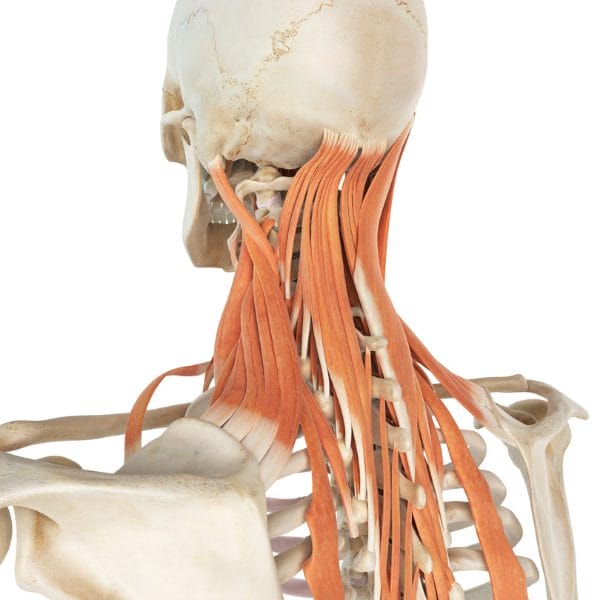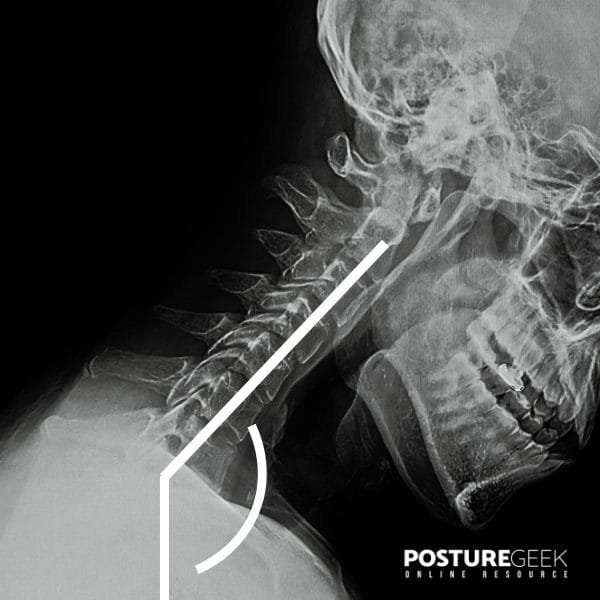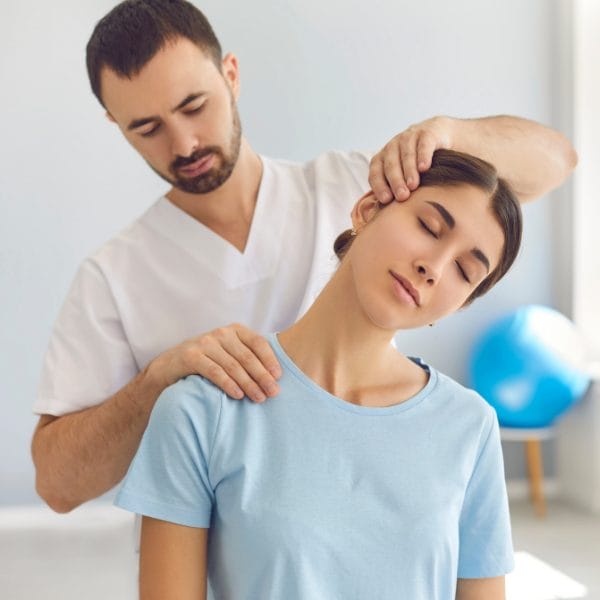Text Neck: Signs Your Spine Is Out of Line
Spending prolonged periods on your screen will take you deeper into a pattern of neck tension and limited range of movement.
PostureGeek.com Tweet

Most of us use smartphones, tablets and computers every day. We scroll through social media feeds, answer emails and watch videos on Youtube- all with our necks stuck at a large angle as we hunch over our screens to see the screen more clearly. Spending prolonged periods on your screen will take you deeper into a pattern of neck tension and limited range of movement. This is called “Text Neck” or “Tech Neck”, leading to serious health problems, including back and neck pain, headaches and carpal tunnel syndrome.
What causes text neck?
The root cause of text neck is the position we put our neck in when looking at screens. This unnatural posture can cause the spine to curve, which puts pressure on the nerves and discs in the neck. Over time, this can lead to long-term damage and chronic pain
A heavy weight on your shoulders
The more you look down, the farther your head moves forward, changing the center of gravity - and adding to neck and shoulder pain.
PostureGeek.com Tweet

Your head weighs about 12 pounds at 0 degrees of head tilt (neutral neck). The heavier the head becomes on the neck, the more you move the head forward and/or down.
When your head reaches around 30 degrees of head tilt, it can weigh approximately 40 pounds. And as you increase the head tilt and forward motion, the amount of weight increases.
Therefore the more you look down, the farther your head moves forward, changing the center of gravity – and adding to neck and shoulder pain.
What part of your spine is affected by Text Neck?
Text neck usually affects the cervical spine, which is the part of your spine that starts at the base of your skull and goes down to your upper back.
The cervical spine comprises seven small bones, called vertebrae, that are cushioned by discs. These discs act as shock absorbers and help keep your spine flexible.
When you hunch over your screen, the weight of your head puts pressure on these discs, which can lead to pain, stiffness and a loss of mobility.
Are the muscles of the neck and shoulders affected by Text Neck?

The muscles in your neck and shoulders are also affected by Text Neck. These muscles work together to keep your head upright. However, when you hunch over your screen, the muscles in your neck and shoulders become tight and stiff. This can lead to pain and tension headaches, among other things.
The prolonged use of a cell phone or the forward head position at work can cause your neck muscles to become elongated and strained. In contrast, the chest muscles may shorten (tighten) and potentially deteriorate in strength.
What are some common symptoms and signs that you have text neck?
If you have any of the following symptoms, you may want to consider that you have text neck:
- Sudden upper back or neck pain when interacting with your cell or another handheld device.
- You have a constant headache: tightness in the sub-occipital muscle can cause tension headaches.
- Trouble moving your neck freely (stiff neck): when attempting to move the neck after lengthy usage, pain and difficulty in moving the neck are typically experienced.
- You feel tightness and weakness in various muscle groups in your shoulders and upper back.
- Your arms, hands or fingers feel numb or tingly.
- Sharp or stabbing pain in your neck: pain caused by a stinging or burning sensation in the lower region of the neck. It may be localized to one area or dispersed over an area and is often referred to as a dull aching in extreme circumstances.
If you are experiencing any of these symptoms, it’s time to take a break from your screens and give your neck a rest.
What position is your head and neck?

Quite often, there are several similarities with Forward Head Posture. Symptoms can worsen over time and cause long-term health effects if not corrected. With the head protruding forward, the chin is jutting out, and the neck is hyperextended.
The further our head and neck are pushed forward and looking downward, the more our head will weigh, putting an unnatural strain on our neck, shoulders, and entire spinal column.
This position places stress on the muscles and discs in the neck. Over time, this can lead to:
- permanent disc damage
- pinched nerves
- arthritis
- spinal cord compression
Why is Text Neck bad for you?
As you can see, text neck is not only uncomfortable, it can be dangerous. This abnormal posture puts stress on the muscles and discs in the neck, leading to long-term damage and chronic pain.
Text neck is also bad for your mental health. When you’re hunched over your screen all day, you’re not only damaging your spine, but you’re also damaging your mood.
What are some ways I can prevent text neck?
- Make sure your computer screen is at eye level, so you don’t have to hunch over to see it.
- Take breaks every 20 minutes to stand up and move around.
- Stretch your neck and back regularly.
- Use a headset or speakerphone when talking on the phone.
- Hold your mobile device up at your eye level. Avoid looking down at your phone for long periods.
- Keep your phone in a holder or stand while using it.
- Get a screen protector to help reduce glare.
- Adjust the brightness of your screen to match the environment you’re in.
- Use a blue light filter app to reduce the blue light emitted from your screen.
- Invest in an ergonomic desk chair and keyboard.
Text neck is a real problem, but you can protect your spine and stay healthy with a few simple changes.
What are some exercises I can do to help my text neck?

- Chin tucks: Tuck your chin down and hold for 5 seconds. Repeat 10 times.
- Neck rolls: Gently roll your head from side to side, pausing on each side for 5 seconds. Repeat 10 times.
- Shoulder shrugs: Shrug your shoulders up and hold for 5 seconds. Repeat 10 times.
- Forearm stretches: With your elbow at a 90-degree angle, extend your forearm and hand up and hold for 5 seconds. Repeat 10 times.
- Cat-Cow pose: Get on all fours, with your hands below your shoulders and your knees below your hips. Arch your back like a cat, then tuck your chin and round your back like a cow. Hold for 5-10 seconds in each position. Repeat 10 times.
- Aerobic exercises: 30 minutes of aerobic activities, such as walking, jogging or biking, 3 times a week.
Text Neck is a real problem that can lead to some serious health issues if not addressed. So be mindful of your screen position, take breaks often and try these exercises to help loosen up your neck and spine.
What treatments can help with Text Neck?

If you are experiencing any of the symptoms associated with Text Neck, some treatments can help:
- Chiropractic adjustments
- Physical therapy
- Massage therapy or other soft tissue therapy
- Surgery (rarely necessary)
- Braces or neck supports (may help in the short-term)
- Medication (painkillers, muscle relaxants, etc.)
- Cold or heat therapy
- Yoga or
- Pilates
- Stretching exercises
It is essential to see your doctor if you are experiencing any of these symptoms to find the best treatment. However, there are many options available, so there will be something that will help.
Finally
Text Neck is a real problem that can lead to some serious health issues if not addressed. Be mindful of your screen position, take breaks often and try some of the exercises above to help loosen up your neck and spine. Suppose you are experiencing any of the symptoms associated with Text Neck. In that case, it may be necessary to seek some treatments that can help.
Treatments include Chiropractic adjustments, Physical therapy, Acupuncture, Massage therapy, or other soft tissue therapy, Surgery (rarely necessary), Braces or neck supports (may help in the short-term), Medication (painkillers, muscle relaxants, etc.), Cold or heat therapy, Yoga or Pilates, Stretching exercises.
It is essential to see your recognized health care provider if you are experiencing any symptoms to find the best treatment for you. There are many options available, so there is sure to be something that will help.
PLEASE NOTE
PostureGeek.com does not provide medical advice. This information is for educational purposes only and is not intended to be a substitute for professional medical attention. The information provided should not replace the advice and expertise of an accredited health care provider. Any inquiry into your care and any potential impact on your health and wellbeing should be directed to your health care provider. All information is for educational purposes only and is not intended to be a substitute for professional medical care or treatment.
